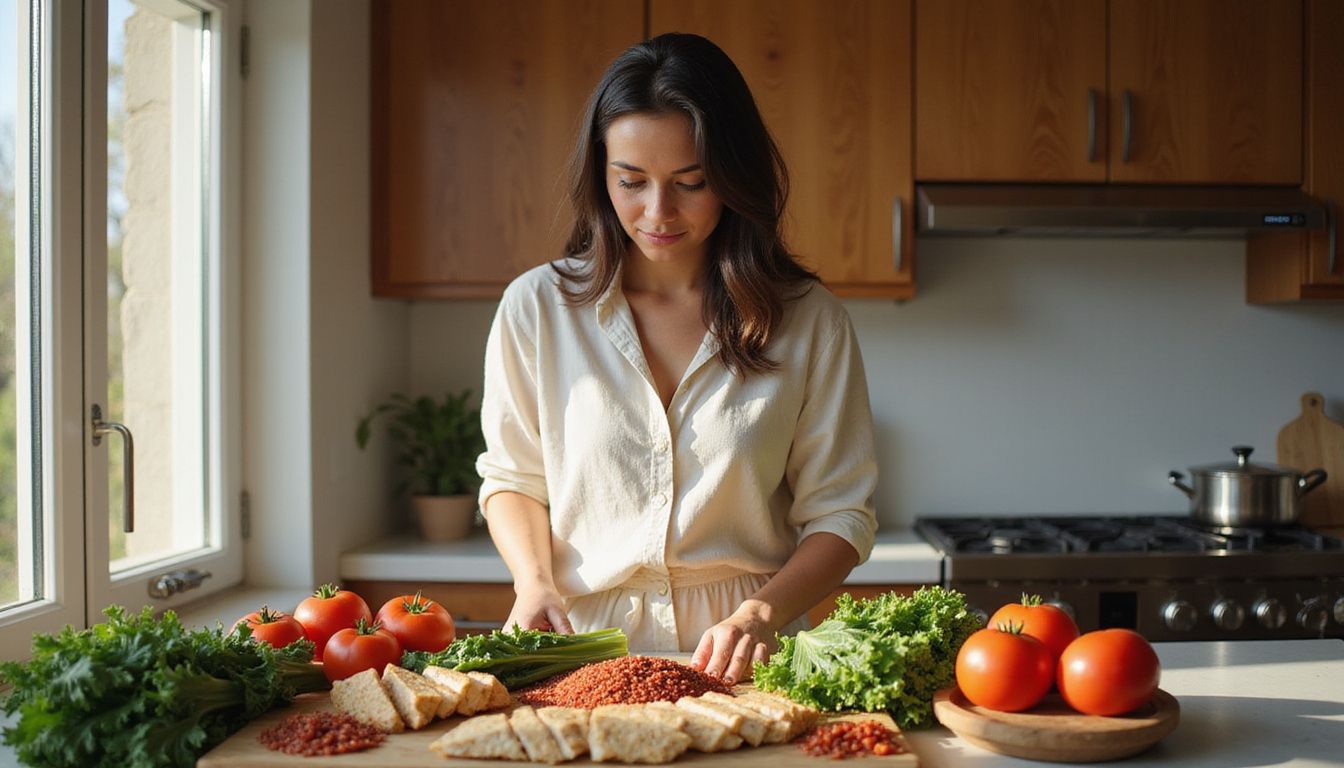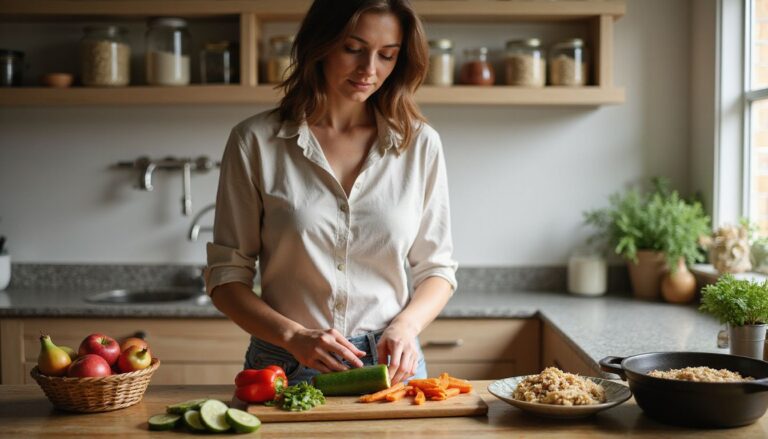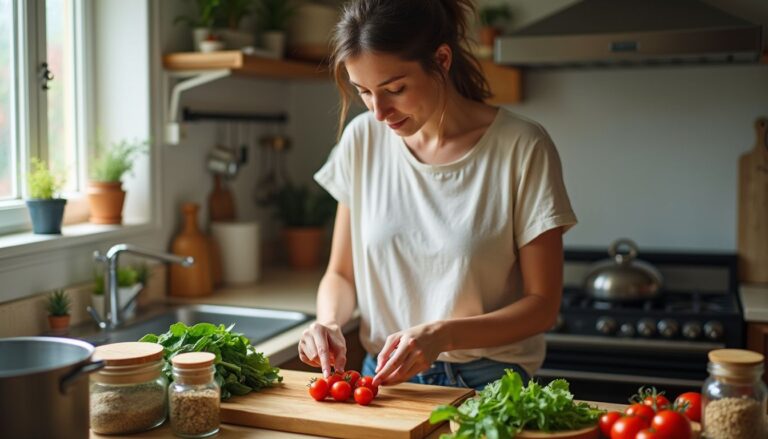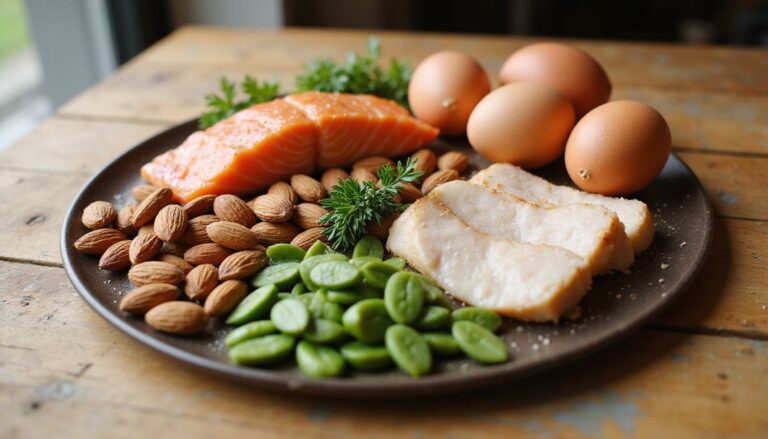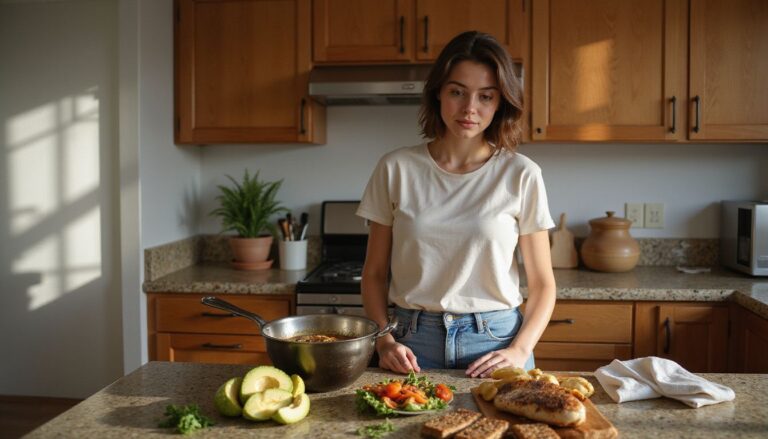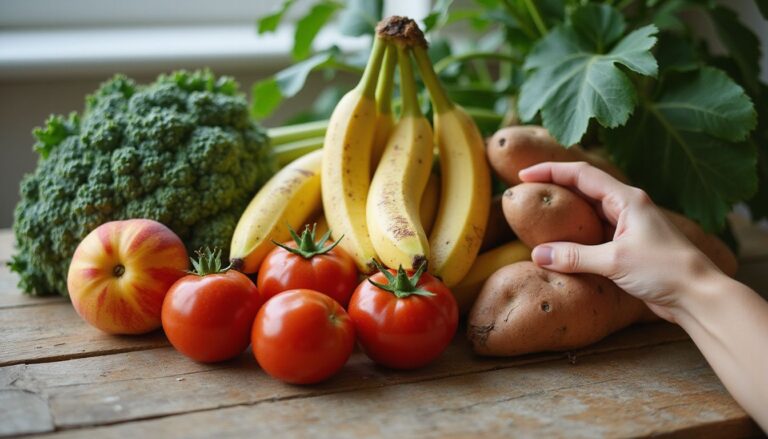Effective Vegan Weight Loss Meal Plan For A Healthier You
Our Nutrition Assistant AI Suite will transform your body. You will lose fat, get toned, and build muscle. Gain confidence and optimal health.
Stuck losing weight even after going plant based? A vegan weight loss meal plan can give you clear structure, steady energy, and real results. With simple swaps and smart portions, you can protect your health and still enjoy food.
This plan, built with guidance from a registered dietitian, shows you how to pick balanced meals, manage portions, and meet daily nutrient needs. You will find step by step ideas and recipes that make healthy habits feel doable for the long term.
Start with small changes today. Your future self will thank you.
Key Takeaways
- A dietitian guided vegan weight loss meal plan can support a safe loss of about 1 to 2 pounds per week while meeting nutrient targets.
- Whole foods like beans, lentils, quinoa, oats, and leafy greens are high in fiber and low in fat, so you feel full on roughly 1,200 to 1,400 calories per day.
- Balanced macronutrients, which means protein, carbs, and fat, matter. Aim for about 56 grams of protein daily for a 62 kilogram adult to support muscle and steady energy.
- Ultra processed vegan items can raise the risk of weight gain and conditions like type 2 diabetes and heart disease, based on 2023 research.
- Vegan diets are linked with lower risk of heart disease, type 2 diabetes, and some cancers. They also reduce water use, land use, and greenhouse gases.
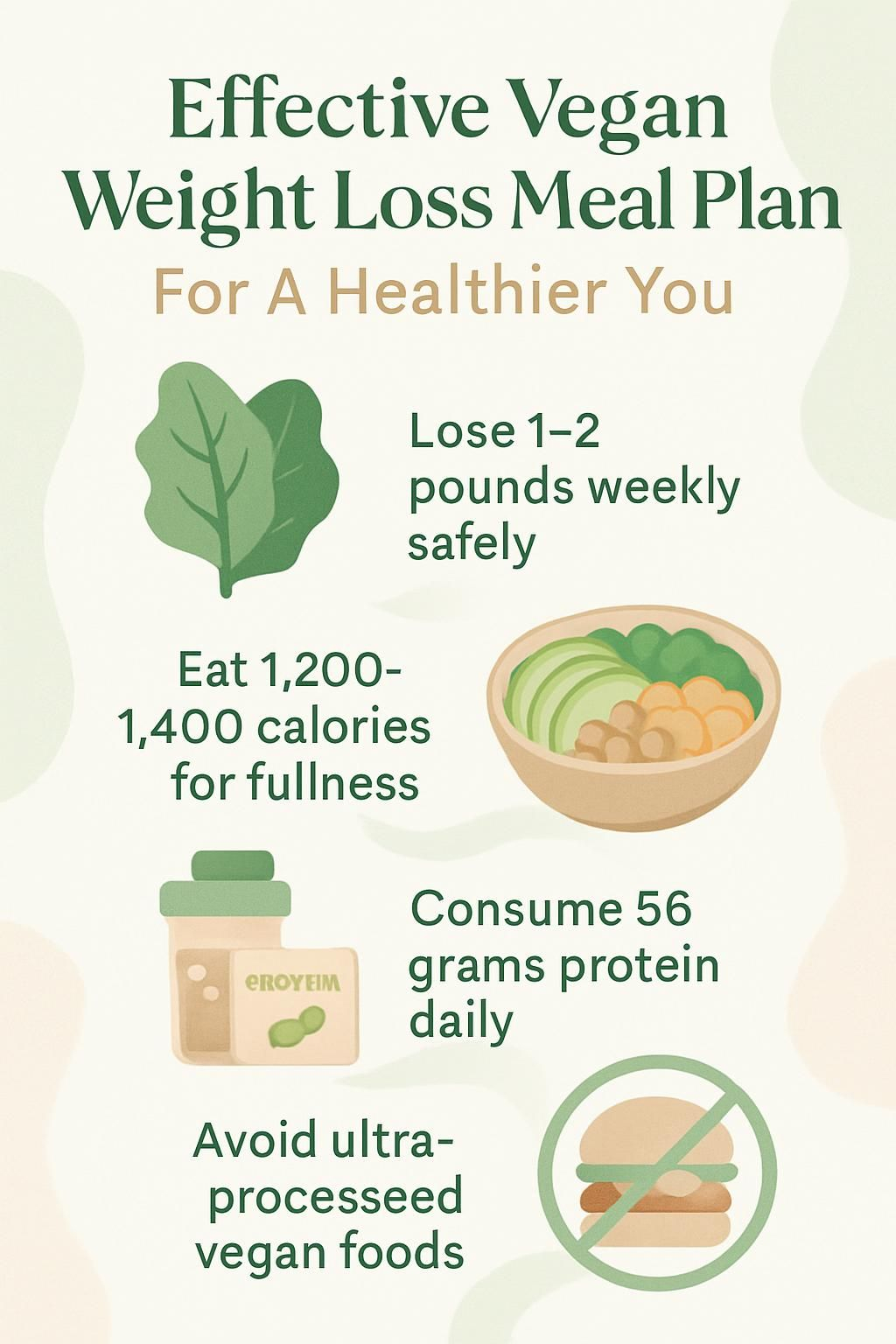
Benefits of a Vegan Weight Loss Meal Plan
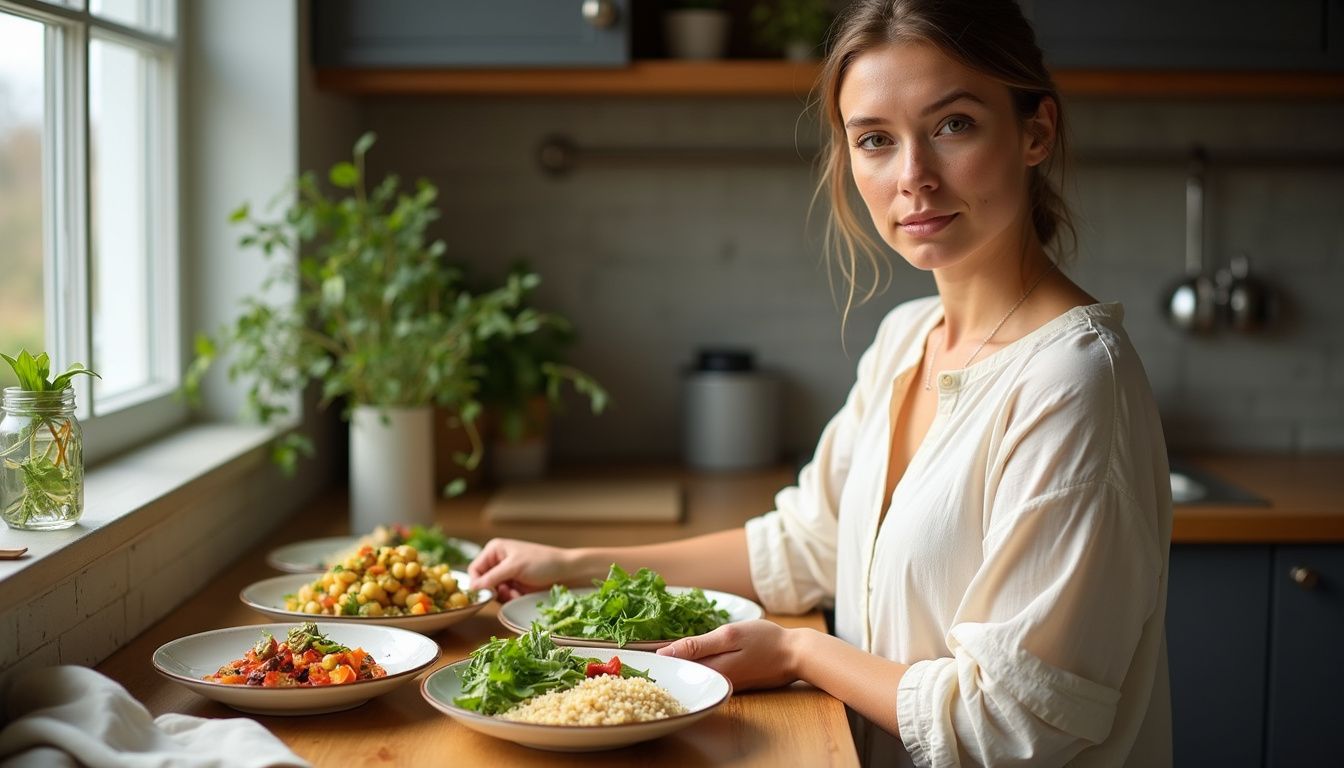
A vegan meal plan centers on nutrient dense foods that help manage weight and deliver key vitamins and minerals. Choosing plant based meals often lowers calories and supports heart health, gut health, and the environment.
How does a vegan meal plan promote healthy weight loss?
Plant based meals tend to be lower in calories and higher in fiber than meals with animal products. Building plates with vegetables, whole grains like quinoa or brown rice, beans, chickpeas, lentils, and fruit helps you feel full on fewer calories.
Studies find people on vegan diets often eat fewer total calories and can lose 1 to 2 pounds per week with good portion control. High fiber foods such as oats, leafy greens, and chia seeds add volume that keeps hunger in check.
Include healthy fats from nuts, seeds, or avocado and protein sources such as tofu or tempeh. This combination supports muscle while you lose fat. Many people stay satisfied on about 1,200 to 1,400 calories per day with this approach.
In short, the right mix of fiber, protein, and healthy fats supports energy, reduces cravings, and makes weight goals easier to keep.
What health benefits can a vegan diet offer?
Moving to a well planned vegan diet may lower the risk of chronic disease. Research links plant based eating with a reduced chance of heart disease, type 2 diabetes, and some cancers.
These diets are often higher in fiber and lower in saturated fat, and they contain no dietary cholesterol. That pattern can support healthy blood pressure, blood lipids, and a diverse gut microbiome, which means the community of helpful bacteria in your digestive system.
The Academy of Nutrition and Dietetics notes that vegan diets can meet needs at all life stages if they are planned well, including a reliable source of vitamin B12. Many people report better energy and easier weight management.
Which nutrient-dense meals support weight loss?
Build meals that mix fiber, protein, and color.
- Leafy salads topped with beans, chickpeas, or lentils for filling fiber and protein.
- Breakfast smoothies with spinach, berries, flaxseeds, and plant protein powder for low calorie volume.
- Oatmeal with nuts and diced red bell pepper for fiber, healthy fats, and steady energy.
- Quinoa bowls with steamed broccoli and black beans for essential amino acids, iron, and magnesium.
Roasted vegetables add phytochemicals, which are plant compounds that support health, and brighten your plate. Whole food ingredients make it easier to keep calories in check.
How is a vegan diet environmentally friendly?
Growing beans, lentils, and whole grains uses less land, water, and energy than raising animals. The American Institute for Cancer Research encourages eating beans often, a common habit in many long lived cultures. This shift lowers greenhouse gas emissions.
Whole foods usually require fewer resources than ultra processed options. Choosing beans, vegetables, fruit, nuts, and seeds helps reduce packaging and waste. I noticed my trash drop by half after I began buying fewer packaged foods.
Key Principles of a Vegan Weight Loss Meal Plan
A successful vegan weight loss meal plan relies on whole foods, balanced macros, and portion control. Use these steps to guide your week of meals.
Focus on whole, plant-based foods
Prioritize fruits, vegetables, legumes, whole grains, nuts, and seeds. Leafy greens, berries, and beans deliver fiber, vitamins, and plant protein that support weight loss and stable energy. Flaxseeds provide heart friendly fats.
Choose nutrient dense picks like onions, turmeric, and lightly cooked vegetables. Unsweetened green or white tea adds antioxidants. Research in the United States links whole food plant based diets with lower rates of obesity and cardiovascular disease. Limit ultra processed products to reduce excess salt and sugar.
Balance macronutrients
Macronutrients are the big three, protein, carbohydrates, and fat. Include plant proteins such as beans, lentils, tofu, tempeh, and quinoa at most meals. Pair grains like brown rice or buckwheat with legumes for complete protein.
Add healthy fats from nuts and seeds, but measure them since they are calorie dense. Many adults do well around 1,400 calories per day for steady loss. A common target is at least 56 grams of protein daily, which you can reach with tofu, edamame, beans, and soy milk.
I once swapped wheat pasta for chickpea pasta and stayed full longer thanks to extra fiber. Track intake with a food tracking app and read labels to monitor calories, protein, carbs, fat, and sodium.
Manage portion sizes
Portions matter, even with healthy foods. Use measuring cups and a kitchen scale for calorie dense items like nuts, seeds, and oils. A simple structure is three 400 calorie meals and one 200 calorie snack each day.
Measure foods like rice, cereal, nut butter, and bread to avoid overeating. This approach keeps you on target without guesswork. It also helps ensure each meal includes enough protein and fiber.
Include adequate protein sources
Protein supports muscle and satiety. Add tofu, tempeh, edamame, beans, lentils, and nut butters to your meals. A general guide is about 0.9 grams of protein per kilogram of body weight.
At 62 kilograms, that is at least 56 grams per day. You can reach it with chickpeas in salads, almond butter on toast, lentil soup, and soy yogurt. Whole plant foods help you maintain muscle while keeping calories reasonable.
Tips for Optimizing Your Vegan Meal Plan
Small tweaks make your vegan weight loss meal plan more satisfying and effective. Plan ahead, choose whole foods, and keep hydration steady.
Why avoid ultra-processed plant-based foods?
Ultra processed vegan foods often contain added sugar, salt, and refined oils. These add calories with little nutrition and can slow weight loss. Many packaged snacks, sweetened drinks, and some meat substitutes also include additives that do not support health.
Research from 2023 links higher intake of ultra processed foods with weight gain and higher risk of type 2 diabetes and heart disease. Choosing whole foods boosts fiber, vitamins, and minerals, which helps you feel full and energized.
Skip liquid calories from sugary drinks and alcohol. Emphasize whole grains, vegetables, beans, and raw nuts for better nutrition. These choices also fit many special diets, including gluten free plans.
How to incorporate high-fiber foods?
Fiber helps you stay full and supports digestion. Many processed foods are low in fiber, so build meals around high fiber picks.
- Start with oatmeal and berries at breakfast.
- Add black beans or lentils to salads, soups, or grain bowls.
- Snack on air popped popcorn or roasted chickpeas.
- Include leafy greens and whole fruits at most meals.
Adults need about 25 to 38 grams of fiber per day. In this plan, Day 1 has 38 grams, Day 2 has 46 grams, and Day 3 offers 34 grams. Tracking fiber helped me keep energy steady during long workdays.
How to monitor calorie intake effectively?
Use a food diary or a calorie tracking app to log meals and snacks. Most apps include large databases of vegan foods, which helps with accuracy. Weigh ingredients with a digital scale to avoid underestimating calories.
The sample plan lists calories for each meal and snack. For example, a protein smoothie might be about 320 calories, and a quinoa and roasted vegetable dinner around 420 calories. Tracking helped me spot hidden calories in nut butters and seeds.
How much water should you drink daily?
Aim for at least 8 cups of water per day. Drinking water before meals can help you feel full and improve hunger cues. You can also include unsweetened green or herbal tea for variety without extra calories.
Staying hydrated may support metabolism and exercise performance. I sip water before meals and while snacking on fruit or nuts, which makes portion control easier. Choose water rich foods like cucumbers and oranges to boost hydration.
Sample 7-Day Vegan Weight Loss Meal Plan
This sample vegan meal plan offers balanced options for each day. Use it as a guide, then adjust portions to fit your needs and activity level.
Day 1:
Breakfast: two vegan pancakes with 1/4 cup blackberries and 1 tablespoon peanut butter. Morning snack: 3/4 cup edamame pods for extra protein and fiber.
Lunch: white bean and avocado toast with 1 cup sliced cucumber. Afternoon snack: one small plum.
Dinner: falafel salad with lemon tahini dressing. Totals for Day 1, about 1,221 calories, 50 g protein, 137 g carbs, 38 g fiber, 59 g fat, and 1,586 mg sodium.
Make extra pancakes now and freeze for quick breakfasts on Days 1, 5, and 7.
What is a healthy vegan breakfast for weight loss?
A balanced breakfast keeps cravings down. Two vegan pancakes, 1/4 cup blackberries, and 1 tablespoon peanut butter give about 296 calories with fiber and plant protein.
Meal prep helps. Freeze pancakes so mornings stay simple. A glass of warm water can support hydration and digestion as you start the day.
What should you eat for lunch on a vegan diet?
Try white bean and avocado toast with 1 cup sliced cucumber. It has about 245 calories and offers fiber, protein, and healthy fats. Beans support muscle during weight loss and avocado helps control hunger.
Rotate options to avoid boredom, like lentil salads, quinoa bowls, or chickpea wraps. I stay focused in the afternoon when lunch includes at least 10 grams of fiber and a protein source.
What is a balanced vegan dinner option?
A falafel salad with lemon tahini dressing is a strong choice at about 499 calories. Build bowls with colorful vegetables, legumes, and whole grains such as brown rice or ancient wheat.
Finish with nuts or seeds for healthy fats. This mix supports recovery after activity and keeps evening hunger in check.
Day 2:
Breakfast: peanut butter and chia berry jam English muffin, 262 calories. Morning snack: 1/2 cup edamame pods.
Lunch: four cups of white bean and veggie salad, about 360 calories. Dinner: two cups of black bean quinoa bowl, around 500 calories.
Day totals, about 1,222 calories, 48 g protein, 153 g carbs, 46 g fiber, and 1,370 mg sodium. Cook a batch of basic quinoa today to reuse on Day 5.
What are some easy vegan breakfast ideas?
Keep mornings simple. An English muffin with peanut butter and chia berry jam is fast and filling. Batch cook a quinoa chia oatmeal mix and store it for up to a month for quick breakfasts.
Other ideas include overnight oats with unsweetened almond milk and fruit or a tofu scramble with spinach for extra protein.
How to prepare a nutritious vegan lunch?
Make a 4 cup white bean and veggie salad. Combine beans, cucumbers, tomatoes, bell peppers, red onion, and spinach. Add quinoa or brown rice for extra fiber and fullness. Toss with a lemon tahini dressing.
Beans provide protein and folate. Vitamin C from vegetables helps with iron absorption. Creatine, a compound that supports muscle power, does not occur in plants, so some athletes choose a supplement if needed. Talk with a healthcare professional before starting any supplement.
What makes a vegan chili weight-loss friendly?
Vegan chili made with beans and quinoa is high in fiber and protein, so it keeps you full on fewer calories. Two cups often land near 500 calories and deliver steady energy.
The bean grain combo can help stabilize blood sugar, which supports appetite control during weight loss.
Day 3:
Breakfast: peanut butter banana cinnamon toast, 266 calories. Snack: 2 tablespoons pumpkin seeds, 114 calories. Lunch: green salad with edamame and beets, 325 calories. Snack: air popped popcorn, 62 calories.
Dinner: 1.5 cups roasted cauliflower and potato curry soup with toasted pita and 1/3 cup hummus, about 446 calories. Day 3 totals, about 1,213 calories, 49 g protein, 132 g carbs, 34 g fiber, 57 g fat, and 1,760 mg sodium.
Save extra soup for Day 4 lunch to simplify prep.
How to make a vegan chia pudding?
Stir 3 tablespoons chia seeds into 1 cup unsweetened soy milk. Let it sit 5 minutes, stir again, then chill at least 2 hours or overnight. The seeds thicken into a pudding rich in fiber and omega 3 fats.
Top with berries or banana and a sprinkle of cinnamon or chopped nuts. I prep several jars at once and keep them for up to four days.
What is a Buddha bowl and why is it good?
A Buddha bowl layers whole grains, legumes, and colorful vegetables in one bowl. The mix delivers protein, slow carbs, fiber, and key minerals like magnesium and iron.
Measuring each part helps with portions, which supports weight goals. For example, the Day 2 black bean quinoa bowl combines protein and fiber for lasting fullness.
What are healthy vegan pasta options?
Choose whole wheat or chickpea pasta. One cup of cooked chickpea pasta has about 14 grams of protein and 8 grams of fiber. Whole wheat pasta gives roughly 7 grams of protein and 6 grams of fiber per serving.
Add vegetables like spinach, bell peppers, or broccoli and use sauces made from tomatoes, roasted peppers, or a light pesto. I like chickpea noodles with kale, cherry tomatoes, white beans, and lemon tahini sauce. It keeps me satisfied through busy afternoons.
Day 4:
Breakfast: cook 1/3 cup quinoa chia oatmeal mix in 1.25 cups unsweetened soy milk, about 296 calories. Prep the dry mix ahead and store up to one month for quick mornings.
Lunch: a hummus wrap with whole grain tortillas and crisp vegetables like spinach, carrots, cucumbers, and tomatoes. Dinner: choose a lentil stew or baked tofu for a strong plant protein that supports weight loss and satiety.
These meals are fast to assemble and keep energy steady during long days.
What are wholesome vegan breakfast choices?
High fiber options work best. Try quinoa chia oatmeal with soy milk for complete protein and minerals. Add nuts or berries for flavor and antioxidants.
Other choices include whole grain vegan pancakes with ground flaxseed, chia pudding, or a green smoothie with spinach and fruit. Each option offers hydration and nutrients to start the day.
How to make a vegan hummus wrap?
Spread 2 tablespoons hummus on a whole grain tortilla. Layer spinach, grated carrots, cucumber slices, bell peppers, and tomatoes. Add roasted chickpeas for extra protein and crunch.
Roll tightly and chill if prepping ahead. A large wrap with hummus plus legumes can provide about 10 grams of protein, which helps maintain muscle during weight loss.
What are good vegan dinner proteins?
Chickpeas, lentils, tofu, and tempeh are reliable dinner proteins. One cup of cooked lentils has about 18 grams of protein, and a half cup of tofu offers around 10 grams.
Make chickpea curry, lentil soup, tofu stir fry, or tempeh tacos. I enjoyed baked tofu with soy sauce and herbs over brown rice and broccoli last week. It was simple and satisfying.
Day 5:
Breakfast: two vegan pancakes with 1/4 cup blackberries and 1 tablespoon peanut butter. Lunch: veggie and hummus sandwich, about 325 calories. Snack: 1/2 cup edamame pods.
Dinner: one cup chickpea curry over one cup basic quinoa, about 487 calories. Day 5 totals, about 1,208 calories, 44 g protein, 149 g carbs, 33 g fiber, 50 g fat, and 1,253 mg sodium.
These meals are simple to prep and keep you full without excess calories.
How to make a protein-packed vegan smoothie?
Blend 1 cup soy milk or pea milk with 1 tablespoon nut butter, 1 tablespoon chia seeds, 1/2 frozen banana, and 1 cup berries. Blend until smooth.
This smoothie gives roughly 15 to 20 grams of protein. Use it as breakfast or a snack to curb hunger between meals.
What is a good vegan lunch salad?
Start with leafy greens like spinach, kale, or romaine. Add 1/2 cup beans for protein and fiber. Pile on bell peppers, carrots, cucumbers, and tomatoes. Finish with a tablespoon of walnuts or pumpkin seeds for healthy fats.
Keep dressing to about 2 tablespoons. I make this in under 10 minutes, and it keeps me full until dinner.
How to prepare stuffed bell peppers vegan style?
Cut tops off bell peppers and remove seeds. Mix cooked quinoa or brown rice with black beans, diced tomatoes, corn, onions, and spices. Stir in chopped spinach or kale.
Fill peppers, place in a baking dish with a splash of broth, cover with foil, and bake at 375°F for 35 minutes. Uncover and bake 10 more minutes until lightly golden. Each serving offers protein, fiber, and vitamins with modest calories.
Day 6:
Breakfast: peanut butter and chia berry jam English muffin, 262 calories. Snack: 1/4 cup hummus with two celery stalks.
Lunch: a vegan bistro lunch box with varied plant items plus 2 tablespoons pumpkin seeds, about 308 calories. Dinner: spaghetti squash with peanut sauce and edamame, 525 calories, plus 1 cup spicy cucumber salad.
Day 6 totals, about 1,211 calories, 51 g protein, 118 g carbs, 32 g fiber, 65 g fat, and 2,065 mg sodium. These meals rely on whole ingredients and keep you satisfied.
What is a tofu scramble and how to make it?
Tofu scramble is a plant based version of scrambled eggs. Crumble firm tofu into a pan and sauté with spinach, tomatoes, or bell peppers. Season with turmeric for color, a pinch of black salt for egg like flavor, and nutritional yeast for a cheesy taste.
Cook 5 to 7 minutes until the tofu is hot and the vegetables soften. Serve with whole grain toast or avocado.
How to make vegan sushi rolls at home?
Place a nori sheet on a bamboo mat. Spread 1/2 cup cooked, cooled sushi rice in a thin layer. Arrange cucumber, carrots, avocado, and tofu or tempeh along the near edge.
Roll tightly, slice into 6 to 8 pieces, and serve with low sodium soy sauce or wasabi. A roll can provide under 200 calories with fiber and up to 9 grams of protein, depending on the filling.
What ingredients are in a vegan Thai curry?
Use coconut milk for a creamy base and add tofu or chickpeas for protein. Include bell peppers, carrots, broccoli, and snap peas for color and crunch. Curry paste typically includes lemongrass, garlic, ginger, chilies, and spices.
This dish delivers vitamins, minerals, fiber, and satisfying flavor. It fits well in a vegan weight loss meal plan when portions are measured.
Day 7:
Breakfast: two vegan pancakes with 1/4 cup blackberries and 1 tablespoon peanut butter, about 296 calories. Snack: one medium orange, 62 calories.
Lunch: four cups green salad with edamame and beets, around 325 calories. Snack: three cups air popped popcorn, 93 calories.
Dinner: noodle bowl with rainbow vegetables and peanut sauce, about 434 calories. Day 7 totals, about 1,209 calories, 45 g protein, 144 g carbs, 32 g fiber, 51 g fat, and 1,732 mg sodium.
What are simple vegan breakfast toast ideas?
Peanut butter banana cinnamon toast offers plant protein, fiber, and potassium. It keeps you full through the morning.
Avocado toast adds healthy fats and fiber. Top with tomato slices or leafy greens for extra vitamins. Fruit on nut butter toast adds antioxidants and natural sweetness.
How to make a chickpea and kale salad?
Rinse 1 cup canned chickpeas. Chop 2 cups kale and massage with a pinch of salt for one minute to soften. Add 1/2 cup sliced beets and 1/2 cup steamed edamame.
Whisk 2 tablespoons tahini, 1 tablespoon lemon juice, 1 teaspoon maple syrup, and 2 tablespoons water. Toss with the salad and top with toasted sunflower seeds. A serving is about 325 calories with balanced macros.
What is a healthy vegan vegetable stir-fry?
Stir fry broccoli, bell peppers, carrots, snap peas, and mushrooms with tofu or tempeh. Use a light sauce of ginger, garlic, and low sodium soy sauce. Keep added oil minimal to limit calories.
Serve over whole grain noodles or brown rice. The noodle bowl with rainbow veggies and peanut sauce in this plan is about 434 calories and gives fiber, protein, and antioxidants.
Vegan Snack Ideas for Weight Loss
Smart snacks help you stay full between meals and prevent overeating later. Aim for about 200 calories with a mix of fiber, protein, and healthy fats.
What are healthy vegan snacks for weight loss?
- Mini fruit and nut bowls or a measured serving of trail mix.
- Roasted chickpeas for a crunchy, high fiber, high protein snack.
- Cucumber sandwiches or air popped popcorn for low calorie crunch.
- Guacamole with whole grain crackers or rice cakes.
- Apple slices with almond butter for fiber and healthy fats.
- Hummus with veggie sticks for a vitamin rich option.
I pack roasted chickpeas for long days. They keep me from reaching for higher calorie snacks.
How to prepare roasted chickpeas?
Drain and rinse one can of chickpeas, then pat dry. Toss with 1 tablespoon olive oil and spices such as smoked paprika, garlic powder, cumin, and a pinch of salt.
Spread on a baking sheet and roast at 400°F for 25 to 30 minutes, shaking the pan halfway. They turn golden and crunchy. Store in an airtight container for up to three days.
Are apple slices with almond butter good snacks?
Yes. Apples bring fiber and vitamins, and almond butter adds healthy fats and a bit of protein. This combo keeps you satisfied and supports appetite control.
A typical serving lands near 200 calories. Many athletes like it for quick energy and steady fullness.
What veggies pair well with hummus?
Celery sticks, carrot sticks, cucumber rounds, and bell pepper strips pair well with hummus. These vegetables are low in calories and high in vitamins and minerals, including vitamin C and potassium.
Crunchy dippers help you slow down while eating, which supports fullness on a vegan weight loss meal plan.
How to make a nutritious trail mix?
Combine 1 cup raw almonds with 1/2 cup walnuts and 1/4 cup pumpkin seeds. Add 1/4 cup dried cranberries or raisins for sweetness and 1 tablespoon dark chocolate chips for flavor.
Portion into small containers to manage calories. Homemade mixes let you control salt and oil and keep the ingredient list short.
Additional Tips for Success
These habits reinforce progress and make your vegan meal plan easier to follow week after week.
How does physical activity support vegan weight loss?
Exercise increases calorie burn and supports a calorie deficit. The CDC suggests at least 150 minutes of moderate activity per week. Movement also helps preserve muscle and can improve insulin sensitivity.
Daily walks, cycling, and light strength training all count. Pairing 30 minute brisk walks with my vegan meals helped me lose weight and sharpen focus.
Why listen to hunger and fullness cues?
Mindful eating can reduce overeating. Eat slowly, pause between bites, and notice how full you feel. This helps your brain register fullness and supports better portion control.
These habits make it easier to enjoy your food and stop when you are satisfied.
How to plan vegan meals in advance?
List breakfast, lunch, dinner, and snacks for the week. Choose recipes that share ingredients to reduce waste and save money. Batch cook staples like pancakes, quinoa, or oatmeal mixes.
Pre portion snacks such as cut vegetables or roasted chickpeas. Use a calendar or meal planning app to schedule prep days and track recipes. This keeps you consistent and limits ultra processed foods.
Conclusion
A structured vegan weight loss meal plan can help you lose about 1 to 2 pounds per week while meeting your nutrition needs. Whole grains, vegetables, legumes, and plant proteins support heart health, steady energy, and long term habits.
With simple meal prep and portion control, you can make progress without feeling deprived. This way of eating supports your well being and reduces your environmental footprint.
For personal guidance, speak with a registered dietitian, especially if you have a medical condition or take medication. Use this plan as a starting point, then adjust to fit your goals and lifestyle.
FAQs
1. What are the main benefits of following an effective vegan weight loss meal plan?
A well-structured plant-based eating pattern can help reduce calorie intake, lower cholesterol levels, and improve heart health. Research from the Academy of Nutrition and Dietetics shows that people who follow a vegan diet often have lower body mass indexes compared to those who eat animal products.
2. How much protein do I need on a vegan weight loss meal plan?
Adults should aim for about 0.8 grams of protein per kilogram of body weight each day according to the Dietary Guidelines for Americans. Plant sources like lentils, tofu, tempeh, beans, and quinoa provide high-quality protein without added saturated fat.
3. Can a vegan meal plan support long-term healthy weight management?
Studies published in journals such as Obesity Reviews indicate that plant-based diets can promote steady fat loss while supporting overall wellness when combined with regular exercise and portion control. Many individuals report sustained energy levels after switching to balanced meals centered around vegetables, whole grains, legumes, fruits, nuts, and seeds.
4. What does a typical day look like on an effective vegan weight loss meal plan?
A sample day may include oatmeal with berries at breakfast; a chickpea salad wrap for lunch; carrot sticks or apple slices as snacks; stir-fried vegetables with brown rice or quinoa for dinner; and fruit or unsweetened yogurt made from soy or coconut milk as dessert or snack options.
Summary: A carefully planned vegan approach offers many health advantages including improved heart function and easier calorie control. Reliable data supports its effectiveness for sustainable fat reduction if meals include enough nutrients from diverse whole foods throughout each day’s menu choices. Personal experience confirms these findings; after adopting this style of eating I noticed better digestion along with gradual but lasting changes in my energy level and waistline size.

